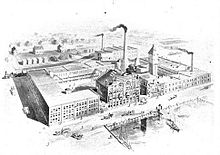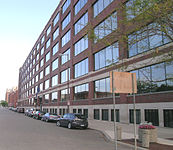Parke-Davis and Company Pharmaceutical Plant | |
 River Place complex on the
Detroit International Riverfront | |
|
Interactive map | |
| Location |
Detroit,
Michigan |
|---|---|
| Coordinates | 42°20′13″N 83°0′59″W / 42.33694°N 83.01639°W |
| Built | 1891 |
| Architect | Donaldson and Meier, Albert Kahn, and Smith, Hinchman and Grylls |
| Architectural style | Romanesque Revival |
| NRHP reference No. | 85002445 [1] |
| Added to NRHP | September 16, 1985 |
The historic River Place (also known as Stroh River Place) is located in Detroit, Michigan, bounded by Joseph Campau Avenue, Wight Street, McDougall Street, and the Detroit International Riverfront. It was formerly the Parke-Davis and Company Pharmaceutical Plant. The complex was listed on the National Register of Historic Places in 1985. [1]
History and significance

In the 1870s, Parke-Davis moved to the riverfront property this complex now occupies. [2] Between 1891 and 1955, the company expanded the complex to cover over 14 acres (5.7 ha), building the 26 structures that still stand. [2] These buildings were designed by some of the most prominent Detroit architects, including Donaldson and Meier, Albert Kahn, and Smith, Hinchman and Grylls. As a group, the buildings in the complex are significant as the represent a wide variety of industrial architecture from the early 20th century.
In 1979, Parke-Davis sold its property in Detroit, including the Research Laboratory, to the Stroh family (of Stroh Brewery Company). [3] The complex, now known as River Place, has been converted into offices, retail space, residences, and a hotel.
Description
These buildings range from brick mill buildings built at the turn of the 20th century to reinforced concrete buildings constructed after 1920 [2] and range from one to six stories in height. [4] The central and northern portions of the complex are tightly packed with interconnected buildings. [4] There is more open space at the southern edge along the river. [4]
The most notable single building in this group is the Riverwalk Hotel Detroit, the former Parke-Davis Research Laboratory, built in 1902 along the Detroit River. This building was the first industrial research laboratory in the U.S. established for the specific purpose of conducting pharmacological research, inaugurating the commercial pure science approach which has driven the rapid development of pharmaceutical technology. [2] [5] The research laboratory was declared a National Historic Landmark in 1976. [6]
Gallery
-
Looking north along Joseph Campau Avenue
-
Looking north along McDougall Street
-
Riverwalk Hotel Detroit, formerly the Parke-Davis Research Laboratory
-
Building in complex
References
- ^ a b "National Register Information System". National Register of Historic Places. National Park Service. April 15, 2008.
- ^ a b c d Parke-Davis and Company Plant and Research Laboratory from the National Park Service.
- ^ Melanie Grunow Sobocinski, Michele Valerie Ronnick, Marlise Beaudoen, Alfred Berkowitz Gallery, Detroit and Rome: Building on the Past, The Regents of the Univ of Michigan, 2005, ISBN 0-933691-09-2, p.97
- ^ a b c Parke-Davis and Company Pharmaceutical Plant from the state of Michigan
- ^ Parke-Davis Research Laboratory from the state of Michigan Dept of History & Libraries
- ^ "Parke-Davis Research Laboratory". National Historic Landmark summary listing. National Park Service. Archived from the original on 2008-06-07. Retrieved 2008-05-03.
- Industrial buildings and structures in Detroit
- Warehouse districts of the United States
- Buildings and structures completed in 1891
- Industrial buildings and structures on the National Register of Historic Places in Michigan
- National Register of Historic Places in Detroit
- 1891 establishments in Michigan
- Romanesque Revival architecture in Michigan





